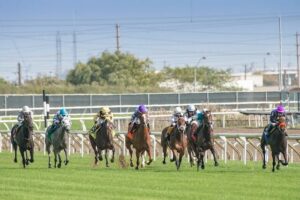 Professional gambler books.
Professional gambler books.
Where do they start and end? In my case, there is no particular order, rhyme or reason. For example, Enemy Number One: The Secrets of The UK’s Most Feared Professional Punter by Patrick Veitch has been sitting on my bookshelf for years.
I’ve not read a word of this well-received tome.
It sits next to me as I write this article. The dust jacket depicting a photo of a man silhouetted walking past a sash window overlooking a garden of bushes, perhaps a pine tree and hedge in the distance. I’m sure the publishers said: ‘You can’t beat a black and white photo and that classic out-of-focus man-in-a-suit look tells a story punters want to read.’
It has taken a few years, but I’m just about the open the book and start reading. This is the equivalent of an unboxing on YouTube!
Enemy Number One: The Secrets of The UK’s Most Feared Professional Punter by Patrick Veitch was published in 2009 by Racing Post.
I’m not sure why I’ve been so slow to get stuck into this book. However, over the next couple of weeks I will read it from cover to cover. One or two of my horse racing friends have said it’s a good read. In truth, most professional gambler books detail the highs and lows of a gambling life via big bets wins and losses. That’s certainly been the case with Dave Nevison’s A Bloody Good Winner & Harry Findlay’s: Gambling For Life.
Have you noticed how all these books have pretty much the same tag lines. I guess being a professional gambler puts your musing within a box that is always square.
No doubt this publication came to fruition from the successes of former worthy reads.
Very few professional gambler books detail the ‘secret sauce’ to help punters find the method to making their betting pay. That’s been the case for Messrs Nevison & Findlay. Perhaps we need to look at my old friend Nick Mordin’s Betting For A Living, published in 1992. I’ve seen that sitting on my brother’s bookshelf.
Anyway, I will soon get stuck into Mr. Veitch.
The blurb on the inside cover gives hope of something more as he made £10M in a period of just eight years. Can the Cambridge mathematician and scholar prove he is the best of all modern-day professionals?
Let’s get reading and find out.
 The 2022 Cheltenham Festival was the first since the government lifted all remaining Covid-19 regulations and, as anticipated, was attended by a record total of 280,627 racegoers over the four days. On the whole, the March showpiece was fairly kind to punters, with 12, or 43%, of the 28 races won by the starting price favourite, or joint-favourite.
The 2022 Cheltenham Festival was the first since the government lifted all remaining Covid-19 regulations and, as anticipated, was attended by a record total of 280,627 racegoers over the four days. On the whole, the March showpiece was fairly kind to punters, with 12, or 43%, of the 28 races won by the starting price favourite, or joint-favourite.
The winning market leaders included Honeysuckle in the Champion Hurdle, Allaho in the Ryanair Chase and A Plus Tard in the Cheltenham Gold Cup. Shishkin, who was sent off marginal odds-on favourite for the Queen Mother Champion Chase, was never travelling well and was pulled up, leaving the race at the mercy of his main market rival, Energumene. Klassical Dream, favourite for the Stayers’ Hurdle, looked the likely winner at one stage, but was less than fluent over the final flight and failed as much as anticipated on the run-in, eventually finishing fifth behind Flooring Porter, who was winning the race for the second year running.
Thus, all the ‘feature’ races of the week went, more or less, as anticipated by the betting market, but the notoriously difficult Festival handicaps were, largely, as impenetrable as ever. In fact, the eight handicap races, hurdles and steeplechases, yielded just one winning favourite, subsequent multiple Grade 1 winner State Man, in the County Handicap Hurdle. The other winners included, in ascending order of starting price, Cool Cody at 22/1, Third Wind at 25/1, Global Citizen at 28/1 and Chambard at 40/1.
Top of the shop, in terms of odds of reward, though, was Commander Of Fleet, trained by Gordon Elliott, who belied odds of 50/1 when scraping home by a short head in the Coral Cup. The eight-year-old gelding had popped up at 40/1 when winning comfortably, off an 8lb lower mark, at Navan in December but, after three unsuccessful starts in Graded company, was largely unconsidered at Cheltenham.
 Famously trained by the late Donald ‘Ginger’ McCain on the sands of Southport Beach on Merseyside, northwest England, Red Rum won the Grand National for the first time in 1973. On that occasion, ridden by Brian Fletcher, Red Rum overhauled long-time leader, Crisp, who had been thirty lengths clear at one stage, in the dying strides to win by three-quarters of a length in a course record time of 9 minutes and 1.9 seconds.
Famously trained by the late Donald ‘Ginger’ McCain on the sands of Southport Beach on Merseyside, northwest England, Red Rum won the Grand National for the first time in 1973. On that occasion, ridden by Brian Fletcher, Red Rum overhauled long-time leader, Crisp, who had been thirty lengths clear at one stage, in the dying strides to win by three-quarters of a length in a course record time of 9 minutes and 1.9 seconds.
Red Rum and Fletcher returned to Aintree for another crack at the celebrated steeplechase in 1974 and duly won again. Despite the welter burden of twelve stone, Red Rum came home seven lengths ahead of his nearest rival, L’Escargot. In so doing, he became the first horse since Reynoldstown, in 1936, to record back-to-back wins in the Grand National and – notwithstanding subsequent reductions in the maximum weight carried – remains the only horse since World War II to carry such a weight to victory. Red Rum finished second in the 1975 and 1976 renewals of the Grand National, in 1975 under Brian Fletcher and in 1976 under Tommy Stack, who replaced Fletcher after the latter made disparaging comments to the press about Red Rum and was informed by McCain that he would not be riding the horse again.
Stack was once again aboard Red Rum when he lined up, as a twelve-year-old, for the 1977 Grand National. Generally regarded as past his prime, Red Rum was, nonetheless, saddled with top-weight once again, albeit just eleven stone and eight pounds, and was sent off joint-second favourite at 9/1. He took the lead at the twenty-second fence, Becher’s Brook on the second circuit, following the departure of favourite Andy Pandy, and stormed home to his unprecedented third win in the race, twenty-five lengths clear of his nearest rival.
 The Triple Crown Series is a title made of three horse racing events. The Kentucky Derby, Preakness Stakes, and Belmont Stakes are the trio that makes up the Triple Crown Series. Most jockeys and trainers would consider this to be their ultimate goal.
The Triple Crown Series is a title made of three horse racing events. The Kentucky Derby, Preakness Stakes, and Belmont Stakes are the trio that makes up the Triple Crown Series. Most jockeys and trainers would consider this to be their ultimate goal.
Since its inception, the Triple Crown Series has proved to be the most difficult feat every three-year-old thoroughbred could complete in horse racing. Since the title was first awarded in 1950, just 13 horses have competed in all three races and come out on top.
Opens to only three-year-old thoroughbred horses in America and even abroad, coming together in these three prestigious races. Local horse breeders and trainers all around the world look forward to being part of the races. The endurance of elite three-year-old thoroughbred horses being tested in this field makes the triple crown series a must-attend racing event for racegoers around the world.
That being said, we’re learning about the tradition and short history of the three races that made up the Triple Crown Series; the Kentucky Derby, Preakness Stakes, and the Belmont Stakes. And more importantly, why all three are must-visit events for many racing fans.
#1 – The Kentucky Derby otherwise known as the “Run for the Roses”
The Kentucky Derby dubbed “Run for the Roses”, happens annually on every first Saturday in the month of May, held in Louisville, Kentucky, and is the first event of the Triple Crown Series. Its first ceremonial race kicked off at the same time as today on May 17, 1875. The Kentucky Derby’s official racing distance for its event is approximately 1 1/4 miles comprising 10 furlongs. Considered to be the ultimate test of endurance, the derby which is also dubbed the “most exciting two minutes in sports’ is reportedly the longest-running sports event in the United States of America.
Short History of the Kentucky Derby
Held first in 1875, the Kentucky Derby was founded by Col. Meriwether Lewis Clark Jr who also founded the Louisville Jockey Club. The construction of the Churchill Downs Racetrack was also initiated by him in 1937. The Kentucky Derby’s first winner was Astride.
The colt at the racecourse was built by jockey Oliver Lewis who was trained by Ansel Williamson. Secretariat’s record as the fastest horse to “Run for the Roses”, finishing the race in 1:59.4 minutes, remains untouched.
The Kentucky Derby returns for its 149th year of racing in the coming month of May. To get a hint of horses lined up in a bid to overthrow the Secretariat’s long-standing record as the fastest horse to “Run for the Roses”, Bet on the Kentucky Derby has all the news, details and horse ranking on their website.
The Kentucky Derby Racing Traditions
In addition to long-standing customs that many viewers adore about this event, the Kentucky Derby features the fastest three-year-old thoroughbreds of their age. Every year, there’s a record of 120,000 Mint Juleps to be served at the Run for the Roses event at Churchill Downs, making it the race’s official cocktail. The names of the Kentucky Derby past-winners are printed on the special glass in which these mint juleps are served. It can be taken home by guests as a memento of the occasion.
The Kentucky Derby is attended by well-dressed racegoers in addition to mint juleps. Female visitors are urged to wear their best cocktail dresses and colourful hats, however, there is no official dress code. Men should likewise dress professionally by donning their formal suits, trousers and a pair of loose-fitting shoes.
#2 – The Preakness Stakes
Preakness Stake’s official venue is located at the Pimlico Race Course, Baltimore Maryland. Much like the Kentucky Derby, the Preakness Stake also features three-year-old thoroughbred horses that would race over a distance of 1 3/16 miles or 9.5 furlongs. Two weeks after the Kentucky Derby ends, this event is traditionally held.
Short History of the Preakness Stakes
A look at the Preakness Stakes history shows the first event was held on May 27. 1873. The event was named after a colt Preakness, who won the Dinner Party Stakes racing event held at the Pimlico for the first time on October 25, 1870, by former Maryland Governor Oden Bowie. The Preakness Stakes, however, was first won by Survivor, who bagged a $2,050 USD winning prize for the race.
According to the viewership ratings, the Preakness Stakes, after the Kentucky Derby, is the second most-viewed horse racing event in the whole of North America.
Preakness Stakes Traditions
There’s not much happening at the Preakness Stakes in terms of tradition other than its long-standing singing of Maryland’s official state song, “Maryland, My Maryland.” While the song is being sung, spectators are encouraged to sing aloud the song’s third stanza bringing the utmost feeling to everyone at the venue. Second is the painting of the winning horse and his jockey in a weather vane of an event infield in the colours of the victorious owner’s silks.
#3 – The Belmont Stakes dubbed “Test of the Champion”
The Belmont Stakes being the longest among the three races in the Triple Crown Series got his name as the “Test of the Champion”. Belmont Stakes is raced at an official racing distance of 1 1/2 miles or 12 furlongs. That’s one hell of course!
The Belmont Stakes is held every year on every second Saturday of June at Belmont Park, Elmont, New York, United States. The first inaugural horse racing at the Belmont Stake came into effect on June 18, 1867.
Short History of the Belmont Stakes
The first Belmont Stakes was sponsored by August Belmont Sr. and held at Jerome Park Racecourse in the Bronx. The first Belmont Stakes was won by a female horse that goes by the name Ruthless.
Sir Barton’s victory in the Belmont Stakes in 1919, following victories in the Kentucky Derby and Preakness Stakes, marked the beginning of the Triple Crown Series. The August Belmont Trophy, which would be given to the winning thoroughbred the following year, was first awarded to the race’s victor in 1926. The winner will receive a silver miniature to keep forever.
Belmont Stakes Traditions
The winner of each race will receive a blanket covered in white carnations. In this way, the event came to be known as “The Run for the Carnations.” “The Sidewalks of New York” is the Belmont Stakes’ opening post-parade song.
From 1997 through 2009, Frank Sinatra’s Theme from New York, New York was used in its place. The following year, it was modified to Jasmine V’s Empire State of Mind. In 2011, a Theme from New York, New York was once again used as the post-parade song.
Conclusion
Every one of the three races herein is crucial to American history. These races serve as a stage for promising thoroughbreds to display their perseverance and vigour as three-year-olds in addition to bringing the horseracing community closer together. The Triple Crown Series has been the goal for these hopefuls, who can only enter these races once.
